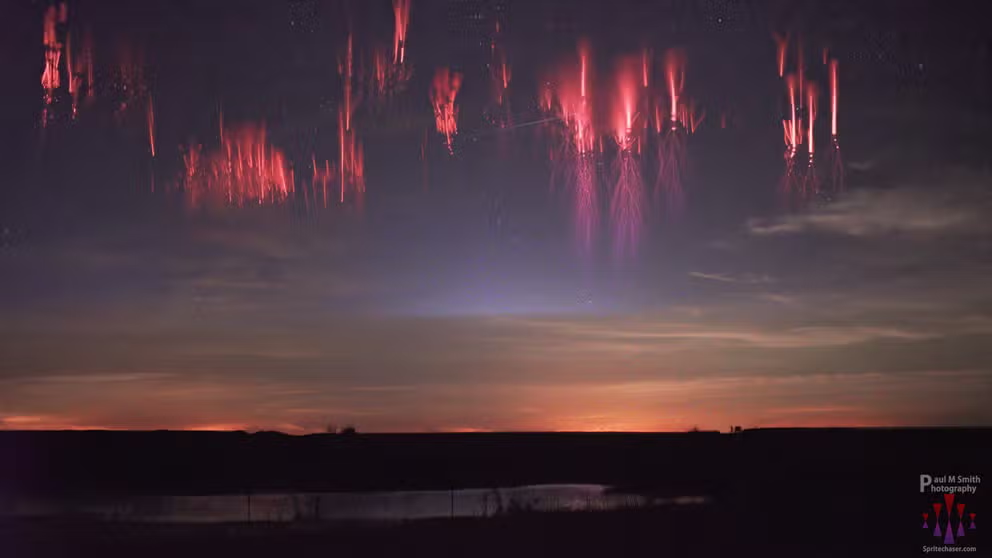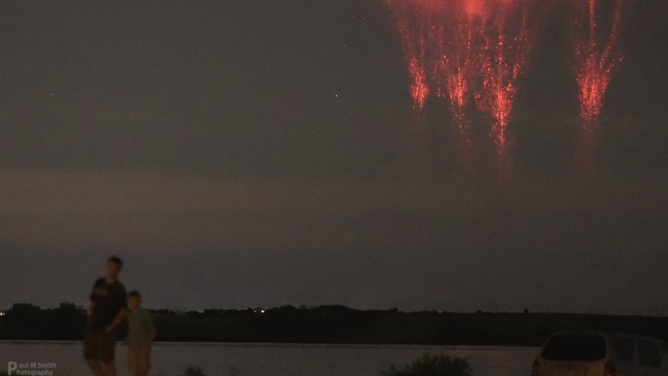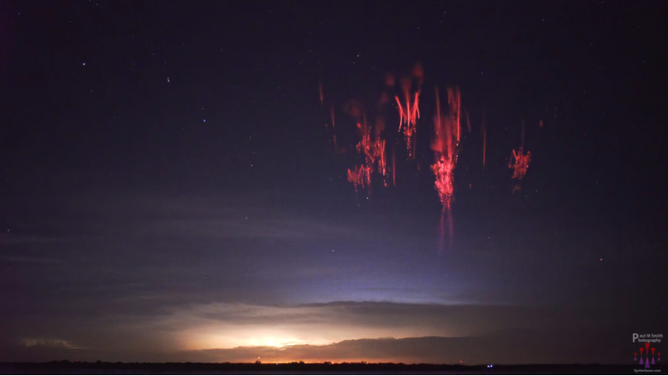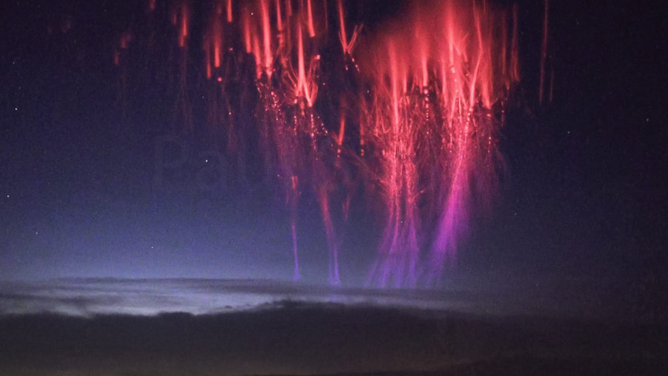Sprites -- not a UFO -- make these mysterious flashes above thunderstorms
Sprites could be visually described as backward bolts of red lightning that mimic the shape of jellyfish. Officially known as a type of "transient luminous events," sprites form in tandem with some intense traditional cloud-to-ground lightning flashes.
What is a sprite? Nature's super rare red lightning explained
A kind of transient luminous event or TLE, sprites are rarely observed with the human eye and how they form is not well understood.
OKLAHOMA CITY – Storm chasers are known for hunting tornadoes, thunderstorms, or even hurricanes and blizzards.
One such chaser in Oklahoma is instead out looking for sprites, though it's not the kind you find on a simple trip to the grocery store.
Paul Smith is an avid outdoor photographer who, while living in Canada, used to chase the Northern Lights, lightning, and other night sky wonders.
"I was interested in Milky Way photography and meteors and stuff," Smith said.
But on a trip to the U.S. to film a meteor shower, Smith captured his first photo of a sprite.
What is a sprite?
Sprites, in simplistic terms, might be visually described as backward bolts of red lightning that mimic the shape of jellyfish or perhaps science fiction-inspired alien invaders.
Officially known as a type of "transient luminous events," sprites form in tandem with some intense traditional cloud-to-ground lightning flashes; only sprites shoot out above the tops of thunderstorm clouds -- sometimes as high as 60 miles, according to NOAA.
But sprites are rather faint and usually not visible with just your eyes, instead requiring sensitive camera equipment. It was a camera in 1989 that captured the first photographic evidence of a sprite, and it's only in recent years such camera equipment has become more readily available to the masses that sprites have been photographed.
Research into sprites is still in the early stages. They are still not fully understood how they form, with one NASA scientist dubbing sprites "one of the least-understood electrical phenomena in Earth’s upper atmosphere."
DEBUNKING 7 MYTHS ABOUT LIGHTNING
Smith says to get sprites, you must first get a very strong lightning bolt beneath the cloud.
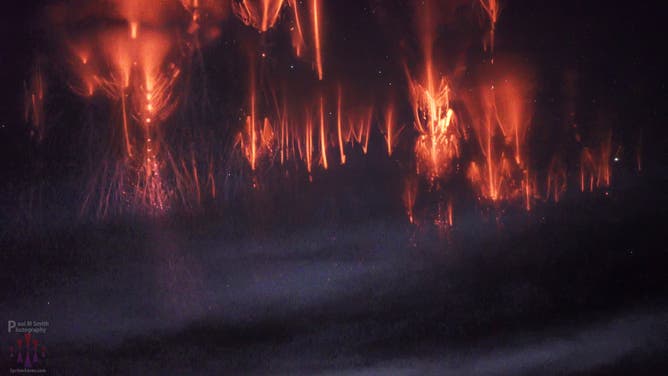
(Paul M. Smith Photography / FOX Weather)
"Like a positive (charged) lightning bolt, so there's lots of charge change in the lower atmosphere, which kind of translates to this breakdown of the upper atmosphere," Smith said. "And what you see with the red is, it's nitrogen atoms getting excited and giving off photons. And that's why you see the red flash. It's basically an electric breakdown of the upper atmosphere caused by electric disturbances below (and) it's only with really strong lightning strikes, so they're not very common."
Smith became hooked on sprites
Smith eventually moved to Oklahoma -- right in the heart of America's tornado alley, where severe thunderstorms capable of strong lightning strikes are common. It's a perfect setup for Smith to chase sprites.
"It's lightning photography and storm photography that really interested me, so everything just kind of merges together," he said. "Night sky and weather, storms -- all these things combined and made me a sprite photographer."
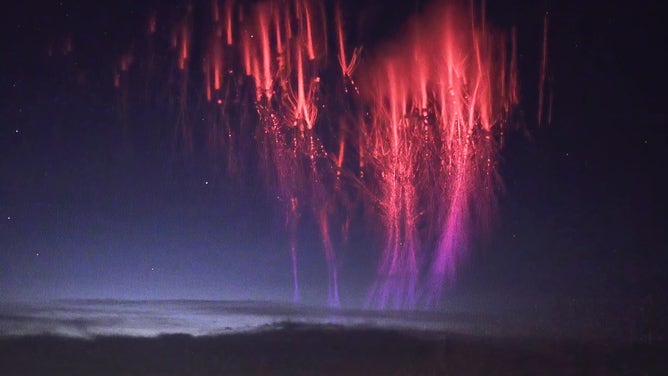
(Paul M. Smith Photography / FOX Weather)
LIGHTNING SAFETY: WHEN THUNDER ROARS, EVEN TAKING OUT THE TRASH CAN TURN DEADLY
Capturing sprites is a different challenge than traditional storm photography as you need to be far enough away from the storm to see high above the cumulonimbus clouds -- and yet, despite a stormy weather pattern, have clear skies around you to allow for distant visibility.
Smith sets his targets, looking for strong thunderstorms that have been going on for a while.
"I find a spot that I can see above it, and then it's a matter of a waiting game," he said. "Many, many tries, and many, many fails. Obviously, when you're in the conditions making storms, your chances of getting clouded over are really high as well."
The search for dark skies
Another challenge is light pollution. Since sprites are so faint, any city or artificial lights will wash out the scene. In Oklahoma, that means dodging not only the lights of Oklahoma City and Tulsa but the various oil derricks.
"So, it's really kind of a game of cat and mouse to find you dark skies," Smith said. But the key to his sprite chases is learning where on the map he can shoot with dark skies. "And when you find them, you kind of bookmark them, and then you can use that in your planning for next time."
'IT SAVES LIVES': GEOSTATIONARY LIGHTNING MAPPER CRUCIAL FEATURE FOR GOES SERIES
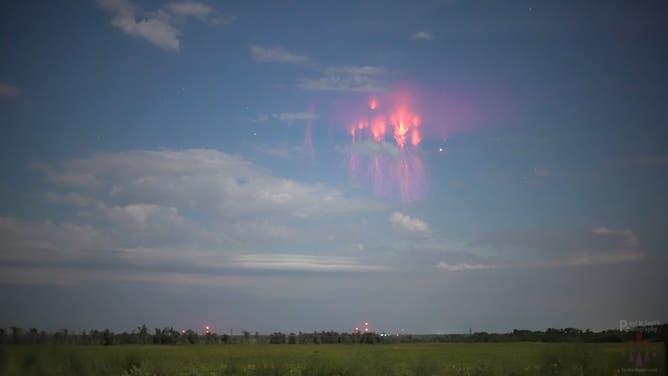
(Paul M. Smith Photography / FOX Weather)
Now that he has sleuthed a host of places in the Midwest that fit the bill, all Smith has to do is match a contending thunderstorm to a dark location.
"I look at my bookmarks, and I kind of formulate a plan in my mind where I think things are going to work out with the composition and go out and trust everything you have."
And now, he brings company.
Smith teaches sprite photography workshops and offers week-long tours around the Midwest with interested photographers looking for the elusive shots. He says he'll help photographers with their set-ups and camera settings, and then it's just a wait-and-see.
"It's really fun chasing around," he said. "We go nocturnal for the week -- sleep till 2 (p.m.) in the afternoon, get up, eat, formulate a plan, then go drive to the spot."
7 types of sprites make every thunderstorm unique
Smith categorizes sprites he's seen into 7 different types: Jellyfish, Carrot, Angel, Tree, Column, Wishbone, and Miscellaneous:
So, which is his favorite to capture on camera?
"Really fascinated with those jellyfish," he said. "I was trying to wrap my head around, like, what is going on to make that?"
He said some of the less intricate and more column-shaped sprites, you can imagine a connection to a lightning bolt.
"When I see a jellyfish sprite with all the intricate tendrils and the heads -- it also seems symmetrical yet random; it's just fascinating to me, the physics that are involved, like 'what is going on?' "
Kids get a front-row seat to science
Smith said his favorite sprite chase was a few years ago with his two sons, who were 7 and 12 at the time.
"We were down at Lake Thunderbird and was seeing sprites," he said. "And we actually started seeing (sprites) with our eyes. So, it was almost like watching a firework display because we're just anticipating the next one."
Smith's child became instantly mesmerized.
"And it was just really, really neat because my 7-year-old was like… he didn't really know what he was seeing and how cool it was, but it was like that raw reaction of not understanding something, but knowing it was kind of cool. It was really fun to share that moment with my kids that night."
IN A FLASH: LIGHTNING CHASER SHARES HOW TO CAPTURE NATURE'S FURY ON CAMERA
But watching the disbelief on the faces of his tour group when they witness a sprite for the first time is a close second.
"I love that whole moment of disbelief," he said. "One guy's reaction was really cool. He was just cursing like, 'Holy s---! I can't believe they're real! I almost came here because I thought this was all phony,'… and he's like, 'it's real!' It's just a really cool reaction."
A 'Spritacular' Project
Smith is already booking tours for the 2023 severe weather season. If you go and capture any sprites on camera, you can help the research community learn more about this mysterious phenomenon.
HOW TO WATCH FOX WEATHER ON TV
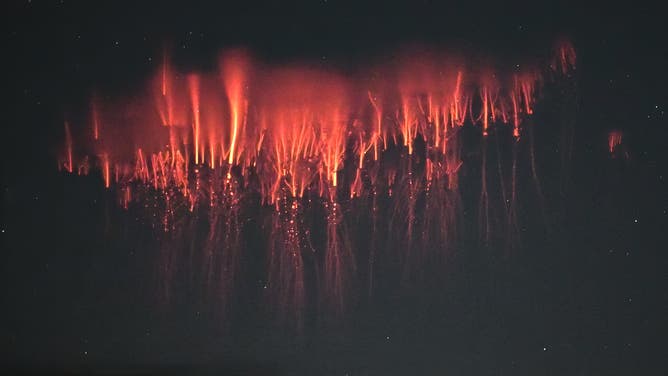
(Paul M. Smith Photography / FOX Weather)
NASA has unveiled a new citizen science project, which they're calling "Spritacular" and asks photographers to submit photos of any sprite captures. You could become part of the credited research, and all photos submitted will be reviewed by scientists.
NASA WANTS YOUR HELP TO UNCOVER MYSTERIES BEHIND BRIGHT FLASHES IN THE SKY CALLED ‘SPRITES’
